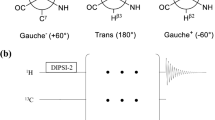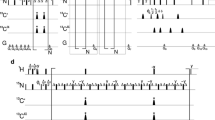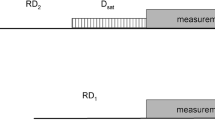Abstract
We have characterized the backbone dynamics of NADH oxidase from Thermus thermophilus (NOX) using a recently-developed suite of NMR experiments designed to isolate exchange broadening, together with 15N R 1, R 1ρ , and {1H}-15N steady-state NOE relaxation measurements performed at 11.7 and 18.8 T. NOX is a 54 kDa homodimeric enzyme that belongs to a family of structurally homologous flavin reductases and nitroreductases with many potential biotechnology applications. Prior studies have suggested that flexibility is involved in the catalytic mechanism of the enzyme. The active site residue W47 was previously identified as being particularly important, as its level of solvent exposure correlates with enzyme activity, and it was observed to undergo “gating” motions in computer simulations. The NMR data are consistent with these findings. Signals from W47 are dynamically broadened beyond detection and several other residues in the active site have significant R ex contributions to transverse relaxation rates. In addition, the backbone of S193, whose side chain hydroxyl proton hydrogen bonds directly with the FMN cofactor, exhibits extensive mobility on the ns–ps timescale. We hypothesize that these motions may facilitate structural rearrangements of the active site that allow NOX to accept both FMN and FAD as cofactors.






Similar content being viewed by others
References
Abragam A (1961) Principles of nuclear magnetism. Clarendon Press, Oxford
Amman C, Meier P, Merbach AE (1982) A simple multinuclear NMR thermometer. J Magn Res 46:319–321
Bai YW, Milne JS, Mayne L, Englander SW (1993) Primary structure effects on peptide group hydrogen exchange. Proteins Struct Funct Genet 17:75–86
Best EPH, Kvesitadze G, Khatisashvili G, Sadunishvili T (2005) Plant processes important for the transformation and degradation of explosives contaminants. Z Naturforsch Sect C J Biosci 60:340–348
Brüschweiler R, Liao X, Wright PE (1995) Long-range motional restrictions in a multidomain zinc-finger protein from anisotropic tumbling. Science 268:886–889
Carrasco B, de la Torre JG (1999) Hydrodynamic properties of rigid particles: comparison of different modeling and computational procedures. Biophys J 76:3044–3057
Cho C, Urquidi J, Singh S, Robinson G (1999) Thermal offset viscosities of liquid H2O D2O and T2O. J Phys Chem B 103:1991–1994
Clore GM, Schwieters CD (2006) Concordance of residual dipolar couplings, backbone order parameters and crystallographic B-factors for a small alpha/beta protein: a unified picture of high probability, fast atomic motions in proteins. J Mol Biol 355:879–886
Connelly GP, Bai YW, Jeng MF, Englander SW (1993) Isotope effects in peptide group hydrogen exchange. Proteins Struct Funct Genet 17:87–92
Dachs GU, Tupper J, Tozer GM (2005) From bench to bedside for gene-directed enzyme prodrug therapy of cancer. Anti Cancer Drugs 16:349–359
de la Torre JG, Huertas ML, Carrasco B (2000) HYDRONMR: prediction of NMR relaxation of globular proteins from atomic-level structures and hydrodynamic calculations. J Magn Res 147:138–146
Delaglio F, Grzesiek S, Vuister GW, Zhu G, Pfeifer J, Bax A (1995) NMRPipe: a multidimensional spectral processing system based on UNIX pipes. J Biomol NMR 6:277–293
Englander SW (2000) Protein folding intermediates and pathways studied by hydrogen exchange. Annu Rev Biophys Biomol Struct 29:213–238
Farrow NA, Muhandiram R, Singer AU, Pascal SM, Kay CM, Gish G, Shoelson SE, Pawson T, Forman-Kay JD, Kay LE (1994) Backbone dynamics of a free and phosphopeptide-complexed Src homology 2 domain studied by 15N NMR relaxation. Biochemistry 33:5984
Farrow NA, Zhang OW, Szabo A, Torchia DA, Kay LE (1995) Spectral density-function mapping using 15N relaxation data exclusively. J Biomol NMR 6:153–162
Gardner KH, Kay LE (1998) The use of 2H, 13C, 15N multidimensional NMR to study the structure and dynamics of proteins. Annu Rev Biophys Biomol Struct 27:357–406
Grzesiek S, Bax A (1992) Correlating backbone amide and side chain resonances in larger proteins by multiple relayed triple resonance NMR. J Am Chem Soc 114:6291–6293
Hansen DF, Yang DW, Feng HQ, Zhou Z, Wiesner S, Bai YW, Kay LE (2007) An exchange-free measure of N-15 transverse relaxation: an NMR spectroscopy application to the study of a folding intermediate with pervasive chemical exchange. J Am Chem Soc 129:11468–11479
Hansen AF, Vallurupalli P, Kay LE (2008) An improved N-15 relaxation dispersion experiment for the measurement of millisecond time-scale dynamics in proteins. J Phys Chem B 112:5898–5904
Hansen DF, Feng HQ, Zhou Z, Bai YW, Kay LE (2009) Selective characterization of microsecond motions in proteins by NMR relaxation. J Am Chem Soc 131:16257–16265
Hecht HJ, Erdmann H, Park HJ, Sprinzl M, Schmid RD (1995) Crystal structure of NADH oxidase from Thermus thermophilus. Nat Struct Biol 2:1109–1114
Henzler-Wildman KA, Lei M, Thai V, Kerns SJ, Karplus M, Kern D (2007) A hierarchy of timescales in protein dynamics is linked to enzyme catalysis. Nature 450:913–916
Hritz J, Zoldak G, Sedlak E (2006) Cofactor assisted Gating mechanism in the active site of NADH oxidase from Thermus thermophilus. Proteins Struct Funct Bioinform 64:465–476
Ikura M, Kay LE, Bax A (1990) A Novel approach for sequential assignment of 1H, 13C and 15N spectra of larger proteins—heteronuclear triple-resonance 3-dimensional NMR spectroscopy—application to calmodulin. Biochemistry 29:4659–4667
Jarymowycz VA, Stone MJ (2006) Fast time scale dynamics of protein backbones: NMR relaxation methods, applications, and functional consequences. Chem Rev 106:1624–1671
Johnson BA, Blevins RA (1994) NMRView: a computer program for the visualization and analysis of NMR data. J Biomol NMR 4:603–614
Kay LE, Muhandiram DR, Farrow NA, Aubin Y, FormanKay JD (1996) Correlation between dynamics and high affinity binding in an SH2 domain interaction. Biochemistry 35:361–368
Kobori T, Sasaki H, Lee WC, Zenno S, Saigo K, Murphy MEP, Tanokura M (2001) Structure and site-directed mutagenesis of a flavoprotein from Escherichia coli that reduces nitrocompounds—alteration of pyridine nucleotide binding by a single amino acid substitution. J Biol Chem 276:2816–2823
Koike H, Sasaki H, Kobori T, Zenno S, Saigo K, Murphy MEP, Adman ET, Tanokura M (1998) 1.8 angstrom crystal structure of the major NAD(P)H: FMN oxidoreductase of a bioluminescent bacterium, Vibrio fischeri: overall structure, cofactor and substrate-analog binding, and comparison with related flavoproteins. J Mol Biol 280:259–273
Korzhnev DM, Skrynnikov N, Millet O, Torchia DA, Kay LE (2002) An NMR experiment for the accurate measurement of heteronuclear spin-lock relaxation rates. J Am Chem Soc 124:10743–10753
Krieger E, Koraimann G, Vriend G (2002) Increasing the precision of comparative models with YASARA NOVA—a self-parameterizing force field. Proteins Struct Funct Genet 47:393–402
Kurumata M, Takahashi M, Sakamoto A, Ramos JL, Nepovim A, Vanek T, Hirata T, Morikawa H (2005) Tolerance to, and uptake and degradation of 2, 4, 6-trinitrotoluene (TNT) are enhanced by the expression of a bacterial nitroreductase gene in Arabidopsis thaliana. Z Naturforsch Sect C J Biosci 60:272–278
Lee LK, Rance M, Chazin WJ, Palmer AG (1997) Rotational diffusion anisotropy of proteins from simultaneous analysis of 15N and 13Cα nuclear spin relaxation. J Biomol NMR 9:287–298
Lipari G, Szabo A (1982) Model-free approach to the interpretation of nuclear magnetic relaxation in macromolecules: 1. Theory and range of validity. J Am Chem Soc 104:4546–4559
Marley J, Lu M, Bracken C (2001) A method for efficient isotopic labeling of recombinant proteins. J Biomol NMR 20:71–75
Morin S, Gagne SM (2009) Simple tests for the validation of multiple field spin relaxation data. J Biomol NMR 45:361–372
Palmer DH, Chen MJ, Searle PF, Kerr DJ, Young LS (2005) Inhibition of NF-kappa B enhances the cytotoxicity of virus-directed enzyme prodrug therapy and oncolytic adenovirus cancer gene therapy. Gene Ther 12:1187–1197
Park HJ, Kreutzer R, Reiser COA, Sprinzl M (1992) Molecular cloning and nucleotide sequence of the gene encoding a H2O2-forming NADH oxidase from the extreme thermophilic thermus-thermophilus HB8 and its expression in Escherichia coli. Eur J Biochem 205:875–879
Parkinson GN, Skelly JV, Neidle S (2000) Crystal structure of FMN-dependent nitroreductase from Escherichia coli B: a prodrug-activating enzyme. J Med Chem 43:3624–3631
Peng JW, Wagner G (1995) Frequency spectrum of NH bonds in eglin c from spectral density mapping at multiple fields. Biochemistry 34:16733–16752
Saksena MP, Harminder, Kumar S (1975) Viscosity of binary liquid mixtures. J Phys C 8:2376–2381
Serban S, El Murr N (2006) Redox-flexible NADH oxidase biosensor: a platform for various dehydrogenase bioassays and biosensors. Electrochim Acta 51:5143–5149
Tanner JJ, Lei BF, Tu SC, Krause KL (1996) Flavin reductase P: structure of a dimeric enzyme that reduces flavin. Biochemistry 35:13531–13539
Vetterling WT, Press WH, Teukolsky SA, Flannery BR (1988) Numerical recipes in C. Cambridge University Press, Cambridge
Wishart DS, Sykes BD (1994) The 13C chemical shift index—a simple method of the identification of protein secondary structure using 13C chemical shift data. J Biomol NMR 4:171–180
Wittekind M, Mueller L (1993) HNCACB, a high sensitivity 3D NMR experiment to correlate amide proton and nitrogen resonances with the alpha- and beta-carbon resonances in proteins. J Magn Res B 101:201–205
Woessner DE (1962) Nuclear spin relaxation in ellipsoids undergoing rotational Brownian motion. J Chem Phys 37:647–654
Yamazaki T, Lee W, Arrowsmith CH, Muhandiram DR, Kay LE (1994) A suite of triple-resonance NMR experiments for the backbone assignment of 15N, 13C and 2H labeled protein with high sensitivity. J Am Chem Soc 116:11655–11666
Zhang OW, Kay LE, Olivier JP, Formankay JD (1994) Backbone 1H and 15N resonance assignments of the N-terminal SH3 domain of Drk in folded and unfolded states using enhanced-sensitivity pulsed-field gradient NMR techniques. J Biomol NMR 4:845–858
Zoldak G, Sut’ak R, Antalik M, Sprinzl M, Sedlak E (2003) Role of conformational flexibility for enzymatic activity in NADH oxidase from Thermus thermophilus. Eur J Biochem 270:4887–4897
Zoldak G, Sprinzl M, Sedlak E (2004) Modulation of activity of NADH oxidase from Thermus thermophilus through change in flexibility in the enzyme active site induced by Hofmeister series anions. Eur J Biochem 271:48–57
Acknowledgments
This work was funded by grants from the Natural Sciences and Engineering Research Council (NSERC) of Canada and le Fonds Québécois de la Recherche sur la Nature et les Technologies (FQRNT). NMR experiments were recorded at the Québec/Eastern Canada High Field NMR Facility, supported by NSERC, FQRNT and McGill University. The authors thank Prof. Mathias Sprinzl (U. Bayreuth) for the generous gift of the NOX expression plasmid. This paper is dedicated to Prof. Lewis Kay on the occasion of his 50th birthday.
Author information
Authors and Affiliations
Corresponding author
Rights and permissions
About this article
Cite this article
Miletti, T., Farber, P.J. & Mittermaier, A. Active site dynamics in NADH oxidase from Thermus thermophilus studied by NMR spin relaxation. J Biomol NMR 51, 71 (2011). https://doi.org/10.1007/s10858-011-9542-0
Received:
Accepted:
Published:
DOI: https://doi.org/10.1007/s10858-011-9542-0




